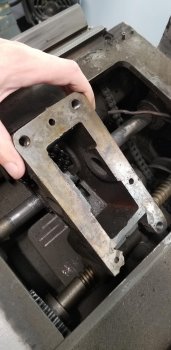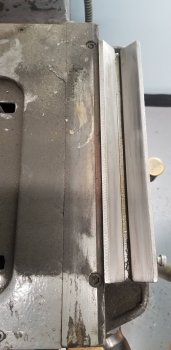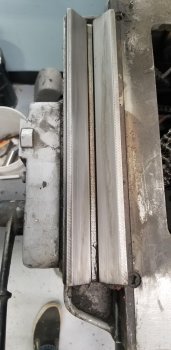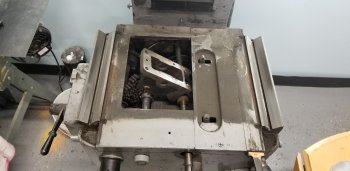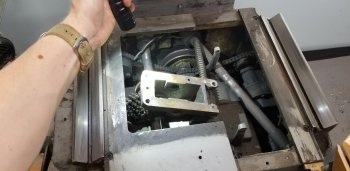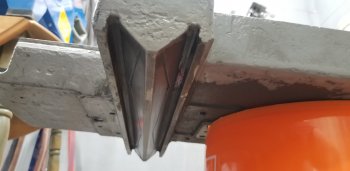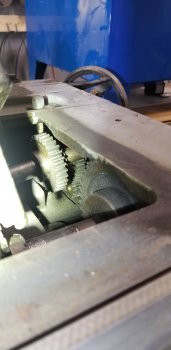You are using an out of date browser. It may not display this or other websites correctly.
You should upgrade or use an alternative browser.
You should upgrade or use an alternative browser.
Surface grinder questions
- Thread starter Stang Bladeworks
- Start date
It's been bringing back old memories reading all this surface grinder advice. Waaaay back almost 50 yrs ago I worked in a tool shop where I used a surface grinder. The biggest thing I remember about it was how expensive those grinder wheels where and actually working things to the tenth of a thou. That amazed me then and still amazes me to work things to those tolerances.
Ya'll who have converted to belts, what tolerance will a belt hold? I'm happy with a thou on my SGA.
Ya'll who have converted to belts, what tolerance will a belt hold? I'm happy with a thou on my SGA.
Stang Bladeworks
KNIFE MAKER
I have realized you were correct about tearing the machine down. I was just being lazy... anyway I started the tear down and I have exposed the ways for x axis travel. I will keep going next weekend. There are some marks but it looks not bad. Im not educated on the machine so I cant say if that amount of wear is acceptable or not. If anyone has any insight im all ears. If I ever want to learn the ins and outs of this machine I may as well dissect it. I have had no luck finding manuals online. If anything stands out to anyone in the pics please let me know.If you are using the "stone" wheels, balancing is usually and exercise in futility...... in other words it can drive you nuts trying to balance those stone wheels. More important than balancing stone wheels, is dressing them to ensure they are true and have a flat contact surface. That being said, IF the arbor, bearings, and other mechanics are in good condition, balancing wheels for knifemaking usually isn't necessary.
OK.... Where the machine mine, the first thing I would do would be to go completely through it, and ensure everything is mechanically sound. IF everything is mechanically sound, I would.... #1 Replace the standard pole chuck, with a fine pole chuck. (that will save you from having small/knife sized pieces of work go flying across the shop)#2 I would convert is to run 2x72 belts. I did it a couple of decades ago, and would never go back to "stone" wheels. It involves replacing the "stone" wheel with a super hard contact wheel, and then constructing an idler wheel setup.... Here's a few pics of mine........ As with anything, there are pros and cons between using "stone" wheels and belts...... for me there are far fewer cons with belts.....plus it saves $$$ because I use the same belts as my grinders......so I don't have to order surface grinder wheels/stones. One of my biggest issues with stone wheels, and a large factor in me converting to belts, is that stone wheels wear away as I'm running the machine....meaning that I can't even remotely rely on the measuring marks on the hand wheels or the machine...... constantly stopping and using the mic or calipers to measure where I am on the workpiece.... a big time consumer.






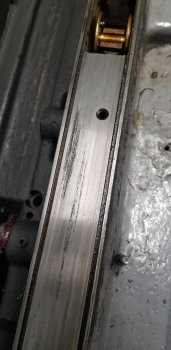
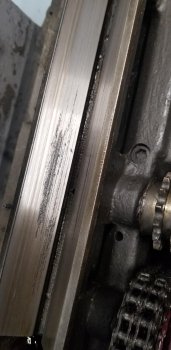
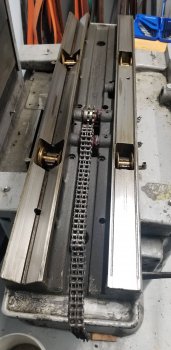
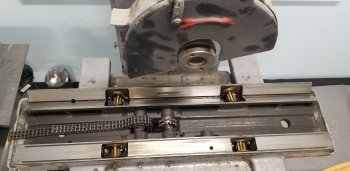
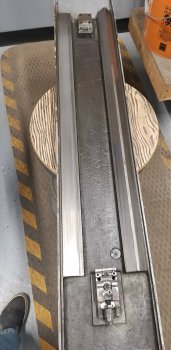
Stang Bladeworks
KNIFE MAKER
The machine ways were oiled I just removed it for the pictures to better show the wear.
Stang Bladeworks
KNIFE MAKER
Smallshop
KNIFE MAKER
Those ways are heavily worn. On a hydraulic machine you can get the ways worn with out realizing if you are always using the hydraulics...and most guys always use it if they have it. So the progressive wear doesn't get noticed.
If the action is smooth on the handwheel....meaning you don't have to work hard to move it longitudinally I would just leave it alone...
if it takes a bit of muscle to crank it however, maybe watch some you tubes on scraping ways or flaking/frosting for oil retention. that machine has settled into itself and is probably more than accurate for knife work....so you would only want to scrape it to "lighten the load" not trying to make it more accurate. When properly scraped the nooks n crannies will hold the way oil thus keeping the ways from contacting each other. as you can see by the tracks there is plenty of galling. not a big deal on a heavy ol' grinder for the accuracy you'll need.
if it is hard to crank...The very first thing I would try is HEAVY way lube and see how it feels...if it helps the "cushion" of lube and is easy to crank...go no further. You don't want to unravel the entire sweater...
I had an old Crystal Lake cylindrical grinder that was that worn...I took an old file and ground a gentle curve on the end (square to the flats)and scraped the ways...not removing all the galling but most. It made a huge difference. I was grinding small parts and not using the full travel on any given part...so accuracy was good. I eventually bought a nicer one and gave that one away. There are places that still rebuild old iron as the castings on most old stuff are better than you get today (and heavier). Surburban Tool has a repair house I believe(there are others too)...any of that stuff will cost a fortune...but if you can youtube videos you can learn a bunch on repair techniques.
A worn out surface grinder always returns the favor...it wears you out...lol.
If the action is smooth on the handwheel....meaning you don't have to work hard to move it longitudinally I would just leave it alone...
if it takes a bit of muscle to crank it however, maybe watch some you tubes on scraping ways or flaking/frosting for oil retention. that machine has settled into itself and is probably more than accurate for knife work....so you would only want to scrape it to "lighten the load" not trying to make it more accurate. When properly scraped the nooks n crannies will hold the way oil thus keeping the ways from contacting each other. as you can see by the tracks there is plenty of galling. not a big deal on a heavy ol' grinder for the accuracy you'll need.
if it is hard to crank...The very first thing I would try is HEAVY way lube and see how it feels...if it helps the "cushion" of lube and is easy to crank...go no further. You don't want to unravel the entire sweater...
I had an old Crystal Lake cylindrical grinder that was that worn...I took an old file and ground a gentle curve on the end (square to the flats)and scraped the ways...not removing all the galling but most. It made a huge difference. I was grinding small parts and not using the full travel on any given part...so accuracy was good. I eventually bought a nicer one and gave that one away. There are places that still rebuild old iron as the castings on most old stuff are better than you get today (and heavier). Surburban Tool has a repair house I believe(there are others too)...any of that stuff will cost a fortune...but if you can youtube videos you can learn a bunch on repair techniques.
A worn out surface grinder always returns the favor...it wears you out...lol.
Stang Bladeworks
KNIFE MAKER
Thanks for the reply. I am not looking to spend a small fortune at this time (or any time really...) I am hoping to fully disassemble and rebuild it using all the proper lubricants. I want to learn how it works and repair any deficiencies. My goal is to get the most out of the machine as is. I would be open to learning how to scrape down the road if needed. Even before I disassembled it the travel was very smooth is all directions. I have no prior experience so I could be off base here. The one handle for x axis travel was extended so the mechanical advantage is greater. I will likely undue this to highlight any further degradation. I signed up for a machinist forum and they recommended a 30wt way oil. Do you have any lubrication recommendations? it seems like the actual threaded rods have lithium grease on them now. I assume that this is fine and the way oil is only for the ways themselves? I'm pretty sure there are grease zerks for the coarser threaded components. I know there are certain types of these that are made for way oil but I don't think so in this case. Any feedback on this? I'm also looking for recommendations on grinding wheels for titanium and hardened steel. Basically I have never owned nor operated a surface grinder so I'm looking for advice from anyone who will give it. Thanks for your time. If you have Instagram I have a short video of me using the machine prior to cleaning it, if that helps you get an idea of the travel at all. @stang_bladeworks if your interested.Those ways are heavily worn. On a hydraulic machine you can get the ways worn with out realizing if you are always using the hydraulics...and most guys always use it if they have it. So the progressive wear doesn't get noticed.
If the action is smooth on the handwheel....meaning you don't have to work hard to move it longitudinally I would just leave it alone...
if it takes a bit of muscle to crank it however, maybe watch some you tubes on scraping ways or flaking/frosting for oil retention. that machine has settled into itself and is probably more than accurate for knife work....so you would only want to scrape it to "lighten the load" not trying to make it more accurate. When properly scraped the nooks n crannies will hold the way oil thus keeping the ways from contacting each other. as you can see by the tracks there is plenty of galling. not a big deal on a heavy ol' grinder for the accuracy you'll need.
if it is hard to crank...The very first thing I would try is HEAVY way lube and see how it feels...if it helps the "cushion" of lube and is easy to crank...go no further. You don't want to unravel the entire sweater...
I had an old Crystal Lake cylindrical grinder that was that worn...I took an old file and ground a gentle curve on the end (square to the flats)and scraped the ways...not removing all the galling but most. It made a huge difference. I was grinding small parts and not using the full travel on any given part...so accuracy was good. I eventually bought a nicer one and gave that one away. There are places that still rebuild old iron as the castings on most old stuff are better than you get today (and heavier). Surburban Tool has a repair house I believe(there are others too)...any of that stuff will cost a fortune...but if you can youtube videos you can learn a bunch on repair techniques.
A worn out surface grinder always returns the favor...it wears you out...lol.
Smallshop
KNIFE MAKER
30 weight is indeed on the heavier side...mobil vactra 4 is a 50 weight oil. If it was smooth by hand before, I'd try the 30 wt. (unfortunately way lube is expensive...) Heavier lube will also make the action a bit harder...so you're trying for that balance. That's a solid old machine. If it's smooth don't mess with it...lol. You can grease screws but some zerk fitting are for oil and would be good to know...oil you'll do more often but it will always be flushing stuff out rather than letting it accumulate. I would call a Norton rep on wheel advice( or any abrasive rep). Ideally a softer more porous wheel will cut cooler but not hold up as well. I always lean towards a softer wheel as burning stuff is a bummer and I don't do production anymore. Anytime you turn the grinder off you will have to dress the wheel again when you start grinding again. A spray mister is good to use on a grinder if you don't have flood coolant.Thanks for the reply. I am not looking to spend a small fortune at this time (or any time really...) I am hoping to fully disassemble and rebuild it using all the proper lubricants. I want to learn how it works and repair any deficiencies. My goal is to get the most out of the machine as is. I would be open to learning how to scrape down the road if needed. Even before I disassembled it the travel was very smooth is all directions. I have no prior experience so I could be off base here. The one handle for x axis travel was extended so the mechanical advantage is greater. I will likely undue this to highlight any further degradation. I signed up for a machinist forum and they recommended a 30wt way oil. Do you have any lubrication recommendations? it seems like the actual threaded rods have lithium grease on them now. I assume that this is fine and the way oil is only for the ways themselves? I'm pretty sure there are grease zerks for the coarser threaded components. I know there are certain types of these that are made for way oil but I don't think so in this case. Any feedback on this? I'm also looking for recommendations on grinding wheels for titanium and hardened steel. Basically I have never owned nor operated a surface grinder so I'm looking for advice from anyone who will give it. Thanks for your time. If you have Instagram I have a short video of me using the machine prior to cleaning it, if that helps you get an idea of the travel at all. @stang_bladeworks if your interested.
The first time you make something flat with a good finish and perfect thickness you will feel like Merlin....
Stang Bladeworks
KNIFE MAKER
Thanks for the info. Ill call a rep and see what they recommend for my application.30 weight is indeed on the heavier side...mobil vactra 4 is a 50 weight oil. If it was smooth by hand before, I'd try the 30 wt. (unfortunately way lube is expensive...) Heavier lube will also make the action a bit harder...so you're trying for that balance. That's a solid old machine. If it's smooth don't mess with it...lol. You can grease screws but some zerk fitting are for oil and would be good to know...oil you'll do more often but it will always be flushing stuff out rather than letting it accumulate. I would call a Norton rep on wheel advice( or any abrasive rep). Ideally a softer more porous wheel will cut cooler but not hold up as well. I always lean towards a softer wheel as burning stuff is a bummer and I don't do production anymore. Anytime you turn the grinder off you will have to dress the wheel again when you start grinding again. A spray mister is good to use on a grinder if you don't have flood coolant.
The first time you make something flat with a good finish and perfect thickness you will feel like Merlin....

